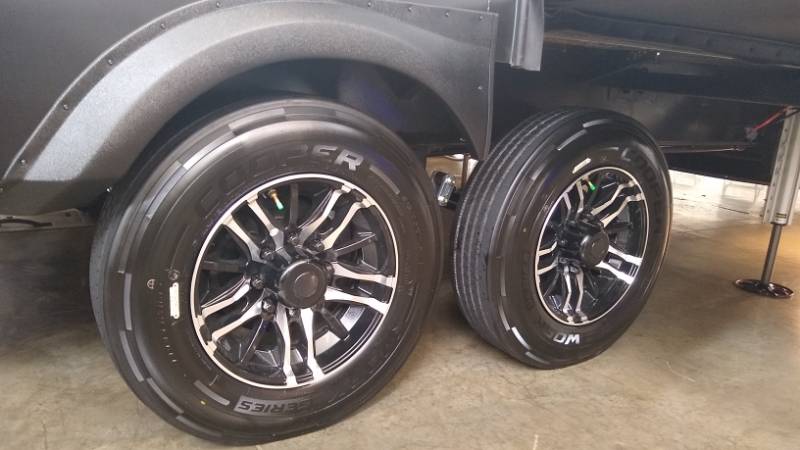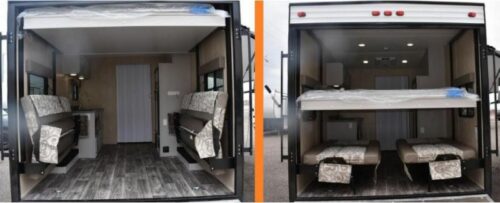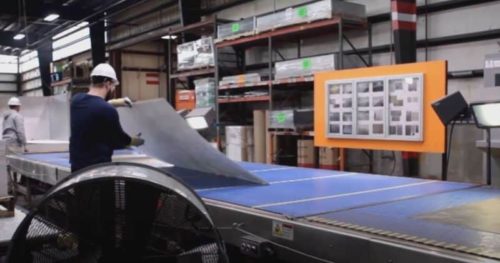What’s the real reason RV tires blow out?
(Hint: It’s not because they’re made by Castle Rock!)
It’s actually a pretty simple answer.
And it’s a problem you can fix yourself for about $12.50.

THE REAL REASON FOR RV TIRE BLOWOUTS IS …
The real reason RV tires blow out is under inflation.
But here’s the real kicker …
Did you know an underinflated tire is also an overloaded tire?
What many people don’t know is that the strength of a tire is based on its inflation pressure.
Just because your tire says it’s rated for 2,180 lbs doesn’t mean you can trust that!
It’s only rated for 2,180 lbs at a certain pressure.
At lower pressure, the tire is weaker.
You can’t treat your RV tires like you treat your car tires.
Automobiles are usually designed with a higher tire reserve capacity. In other words, the tire might be 20-30 percent stronger than what is required to hold the weight of the car, its passengers and its cargo.
That’s not normally true with an RV motorhome or towable. At best, many RVs only have about 10 percent tire reserve capacity.
And that’s only 10 percent on paper – in reality, there’s usually less. That’s because RV companies often assume a motorhome is weighted equally side-to-side, but in many cases, one side is often several hundred pounds heavier than the other!
Another difference between cars and RVs is that cars are usually not loaded to full capacity, or their Gross Vehicle Weight Rating (GVWR). You need quite a few passengers and cargo to fill up most cars! But RVs are commonly loaded to capacity (and many times, even over!).
Run-of-the-mill ST tires, usually on many travel trailers and 5th wheels, are also rated for slower speeds than automobile tires. Many ST tires are only rated for up to 65 mph, although other ST tires are rated for 75 or even 87 mph at continuous use (again assuming proper inflation).
If you’re like most RVers, you enjoy seeing the country wilds! Which means you’re probably driving or towing your RV somewhere off-road, through potholes, gravel, dirt, boulders, mud, and other unpaved substances. Rough terrain is hard on tires.
For all those reasons, an RV tire is often being used close to its design limit. It’s being heavily loaded, driven through tough terrain, sped down the highway, and (possibly) overloaded!
You don’t have any wiggle room. You must ensure your tire is properly inflated for its load.
To help you out, tire manufacturers produce tire load-index tables.
For instance, here is a load-index chart for Goodyear Special Tire tires.

As you can see, an ST205/75-R15 tire is rated for 2,150 lbs at 65 psi.
At 50 psi – at a pressure most people would still consider “fully inflated” – the same tire is only capable of 1,820 lbs. That’s a 330 lb difference!
And you can’t rely on your eye or fingers to detect the difference – especially if you’re running radial-ply tires (mandatory on all new RVs).
“For example, it is difficult to tell just by looking at radial tires whether they are under inflated. Furthermore, when operating a vehicle equipped with radial tires, it is difficult to notice when a tire has gone flat, or nearly flat, since the “feel” of the vehicle does not change significantly.”
Oh, and if you’re running tandem axles, triple axles, or dual axles, all tires on the same axle should be at the same pressure. And they should be inflated to the maximum pressure required to carry the heaviest expected load. All tires on the same axle should be within 2-3 lbs of each other. The maximum allowable difference is 5 psi. Otherwise, overloading will occur.
There’s only one solution to low pressure: a tire pressure gauge.
While there’s nothing inherently wrong with the classic pencil gauge (that gets constantly lost in your center console), a more accurate solution is a digital tire pressure gauge.
But what happens when your gauge says you’re 10 pounds short? Cross your fingers and drive to the nearest gas station!
No!
Most tire manufacturers actually mandate that if a tire has been run 20 percent underinflated, it must be removed and inspected for damage by a professional!
That’s because an underinflated tire runs hot. An underinflated tire:
- Wears faster
- May wear unevenly
- Runs hotter, reduces casing durability
- Kills your fuel economy
- Numbs your vehicle handling
- Increased risk of tread separation (aka tire blowout)
Do everything in your power to never run your RV on an underinflated tire.
(And you can completely ignore the old wives’ tale that you should reduce your tire pressure to increase ride quality. Except in very rare circumstances (mostly severe off-road terrain), you should never reduce tire pressure to soften the ride. That’s the job of your suspension, not your tires!)
Many RVers swear by a portable 12V tire inflator. These little air pumps work well in a pinch to inflate a tire to its proper pressure.
In an emergency, you can even use a bike pump to inflate an RV tire, so long as it’s capable of higher pressures. You’ll give your triceps one helluva workout, though!
P.S. Never inflate a tire beyond the rim pressure! The rim pressure is normally stamped into one of the spokes on the backside.
But before you go around inflating tires, you should know something very important.
Tire pressure is supposed to be measured “cold.”
That doesn’t mean fridge/freezer cold. That means ambient temperature. If you’ve been driving your RV for 45 minutes, the tire will heat up, causing the air pressure to increase. It’s not uncommon to see “hot” tire pressure 10-15 psi more than “cold.” This is normal and safe.
So it’s best practice to measure your tire pressure every morning or at the beginning of a road trip.
In extreme changes in elevation, you may need to adjust your tire pressure. But since tire pressure decreases only about 0.5 psi for every 1,000 feet in elevation, unless you’re gaining at least 10,000 feet, the difference in tire pressure is negligible.
You won’t get accurate results waiting for tires to cool down a gas station. The rule of thumb is it takes about 2-3 hours to tires to cool down to ambient temperature for an accurate pressure reading.
So, as I said, the #1 rule to prevent RV tire blowouts is to air up your tires! Get a pressure gauge and tire inflator, and check your tires every morning and before every trip!
There’s a lot more to learn about proper RV tire care and maintenance.
Here are some of my favorite resources. I encourage you to take advantage of these reading resources and educate yourself!
References
Andy Herrick is a blogging nerd, #8 Enneagram, wannabe bread baker, INTJ, RV industry professional, and small business entrepreneur. He can be found hanging out with his lovely wife and family, skiing, cycling, climbing, hiking, and convincing anyone who will listen why dogs aren’t really that great of pets. Also, he runs this website.
-
Andyhttps://changingears.com/author/andrew-herrick/
-
Andyhttps://changingears.com/author/andrew-herrick/
-
Andyhttps://changingears.com/author/andrew-herrick/
-
Andyhttps://changingears.com/author/andrew-herrick/








